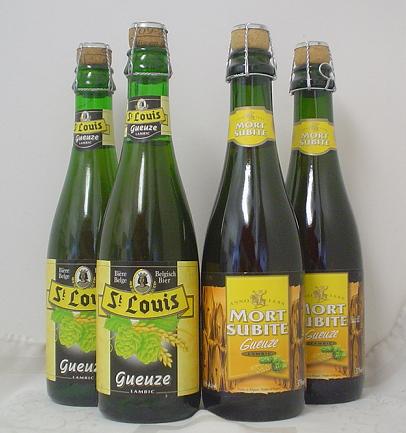 Happy was the lad, then, who came across these two examples of the Belgian style gueuze, which has been described as follows:
Happy was the lad, then, who came across these two examples of the Belgian style gueuze, which has been described as follows:
Gueuze – a word derived from gueux, or begger – is a blend of lambics of different ages, bottled with a champaign-type cork to undergo a second fermentation. It ages well.
“Beers of the World” by G. Delos (pub: CLB, 1994) at page 82
Miachael Jackson in the first edition of his World Guide to Beer describes lambics as follows:
These spontaneously fermenting beers are produced by traditional methods in only a very limited area…called Payottenland, and its atmosphere is held to contain micro-organisms which promote the fermentation of beer without the assistance of the brewer. (at p.117)
So they are rightly called “wild beers”. I have never had a gueuze before though I have had a fair number of the fruit lambics like the little raspberry number I reviewed a couple of weeks ago as well as the cherry version called kriek… including one instance with the brew 19 years ago leading one Parisian barkeep to suggest that we Nova Scotians and the lads from Gascony ought to take out discussions out into the street. But I digress.
So a little pitter-patter of excitement welled up when I saw there on the LCBO shelf not one but two examples of gueuze. Apparently not as much excitement as the guy ahead of me who I was told bought 30 or 40 – which, pushing 4 bucks per 375 ml, was a sure sign of dedication. I was familiar with the line Mort Subite by Brouwerij De Keersmaeker to the west of Brussels so I popped it first. It smelled like a late harvest Riesling or Gewurztraminer white wine as I poured. Fresh, light and only 4.5%. It is brightly acidic but not tannic. I expected more of a sparkling beer but it still effervescent. It is like fruit juce without all aspects of the fruitiness – or perhaps sort of a cross between apple juice and orange juice but not in any forefront manner. Despite this fruity zing, the water is quite soft leaving a very moreish mouthfeel. There is a light bit of the oak cask in the finish, some green antiqued hops as well as the barley, wheat and corn. It is incredibily tasty stuff and quite unlike an ale or a lager. Beyond lovery. Beer advocates have trouble with this one but I think you have to consider that Belgians do challenge. Recently, commenting on someone who gave obvious offence taking the defence that they were merely being “ironic” – despite the implication of cynicism that word connotes – I suggested that such a use of irony was not unlike the defence of a brewer of a bad batch claiming “it’s not off…it’s Belgian!” You have to expect the new and strange from the Belgians and when you do it is wonderful.
So on to the St. Louis by Brouwerij Van Honsebrouck N.V. – the maker of Kasteel quadruple reviewed here last year. It is slightly cloudy and a little bit of an orange tint to the light butterscotch hue. In the mouth it is also fresh but bigger, perhaps sweeter with a drier oaker finish. I could not do better than to repeat the words of Naerhu, a contributor at the beer advocate’s reviews on this beer from Osaka Japan:
White fluffy head on any amazing amber body. Light aroma of red fruit, maybe rasberries. Very lightly sour and pretty sweet. I can hardly imagine this to be a gueuze as sweet and friendly as this is. Where as gueuze normally tastes like how a unclean barnyard smells, this is bright and cheerful, zesty and clean. Very enjoyable.
That being the case, perhaps these two examples of gueuze do not exemplify the style at all. Any input on this point would be very useful for its own sake as well as comment on the LCBO itself. Have they picked only two easy beers rather than great examples or the ur-gueuze? Are they treating us like gueuze mooks or possible future connoisseurs? Neither had any sediment which does raise questions when it comes to Belgian brews.
Gueuze. We can add more examples as the days turn to months and the months to years.
